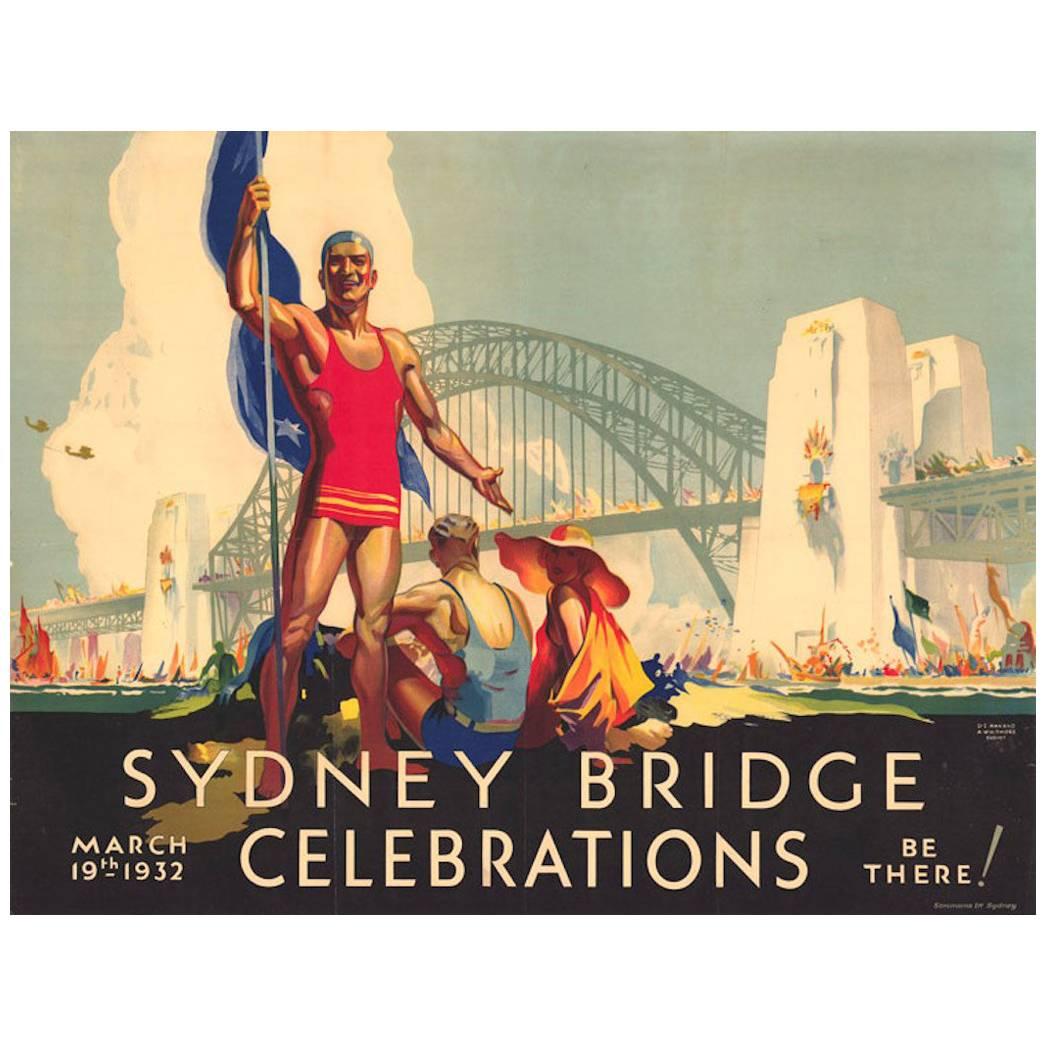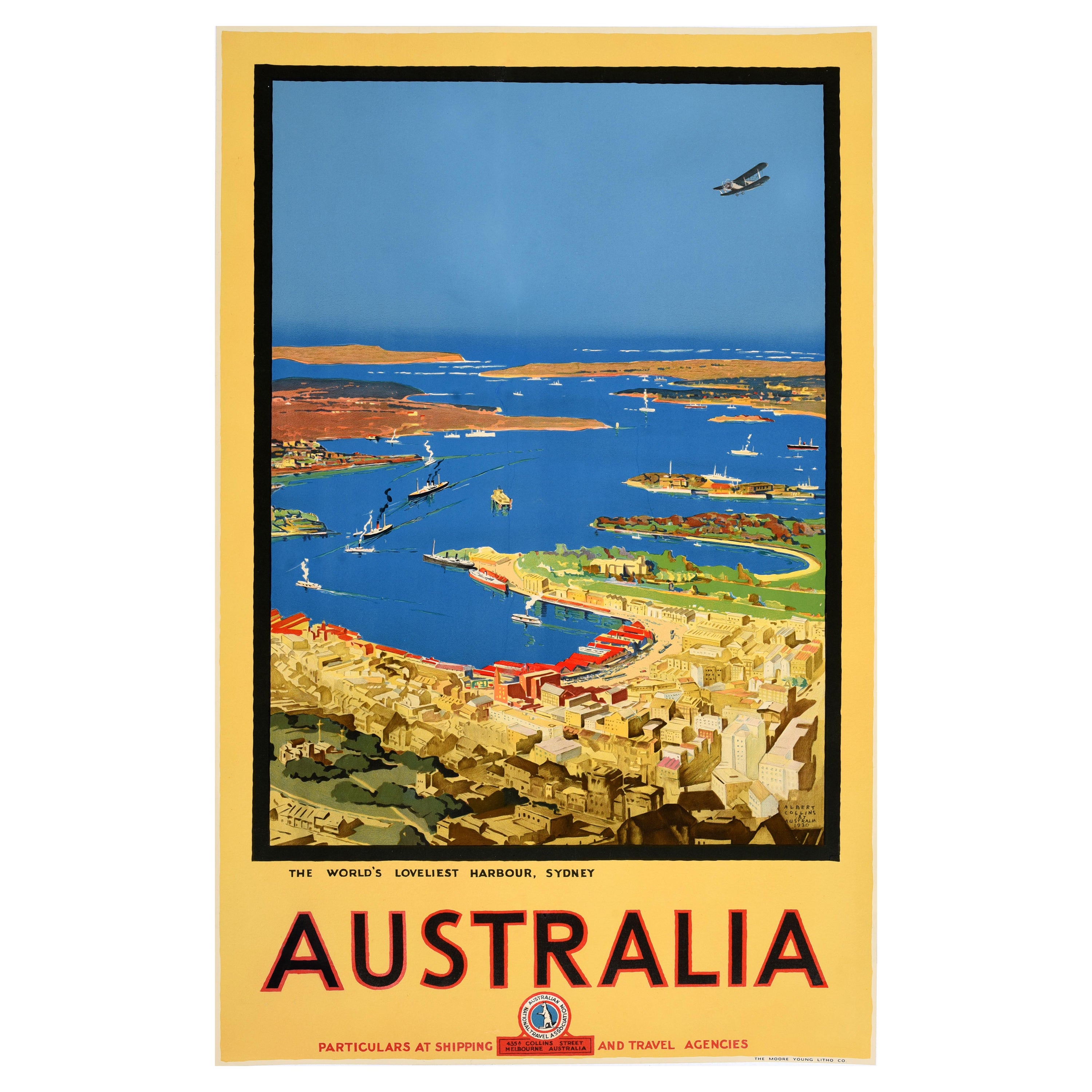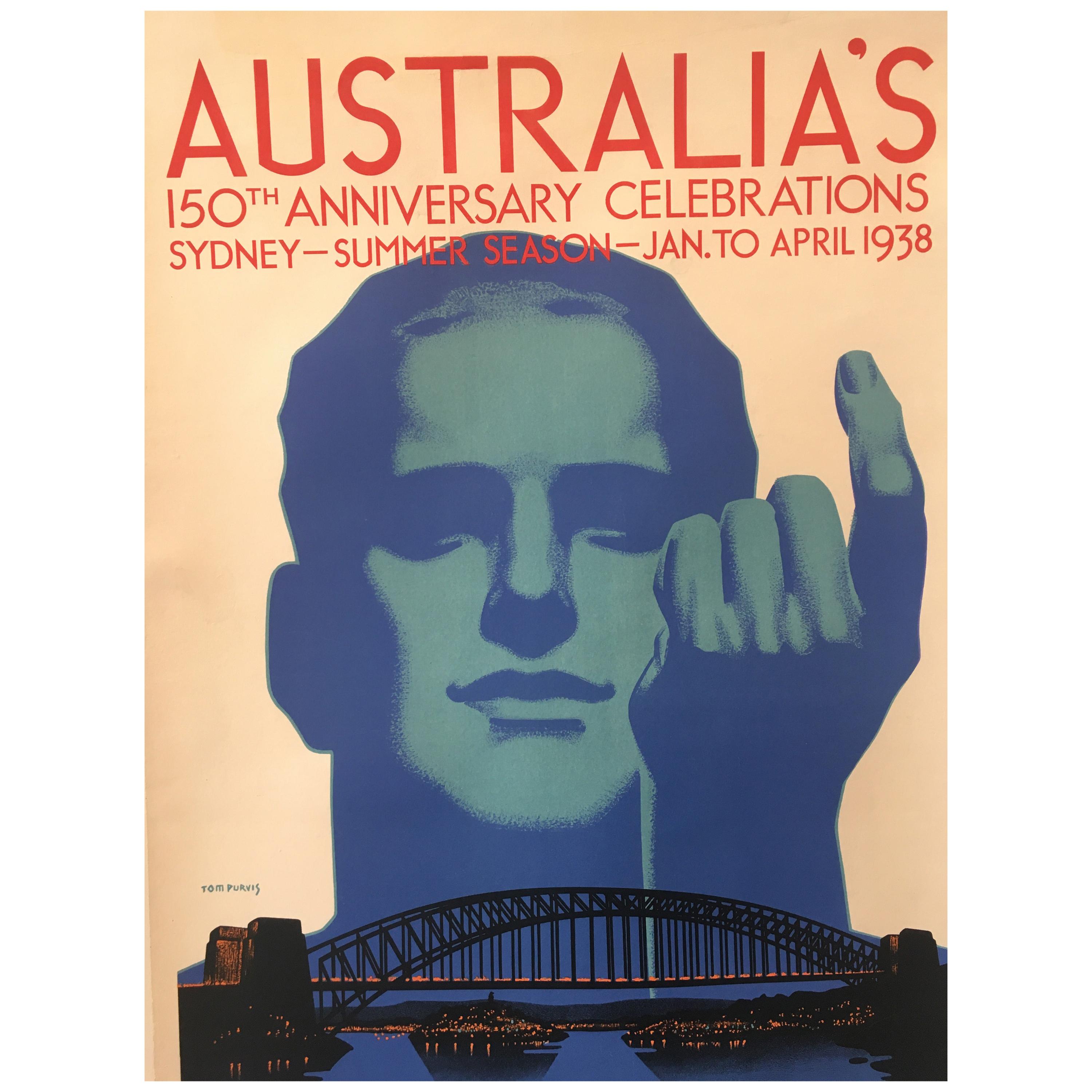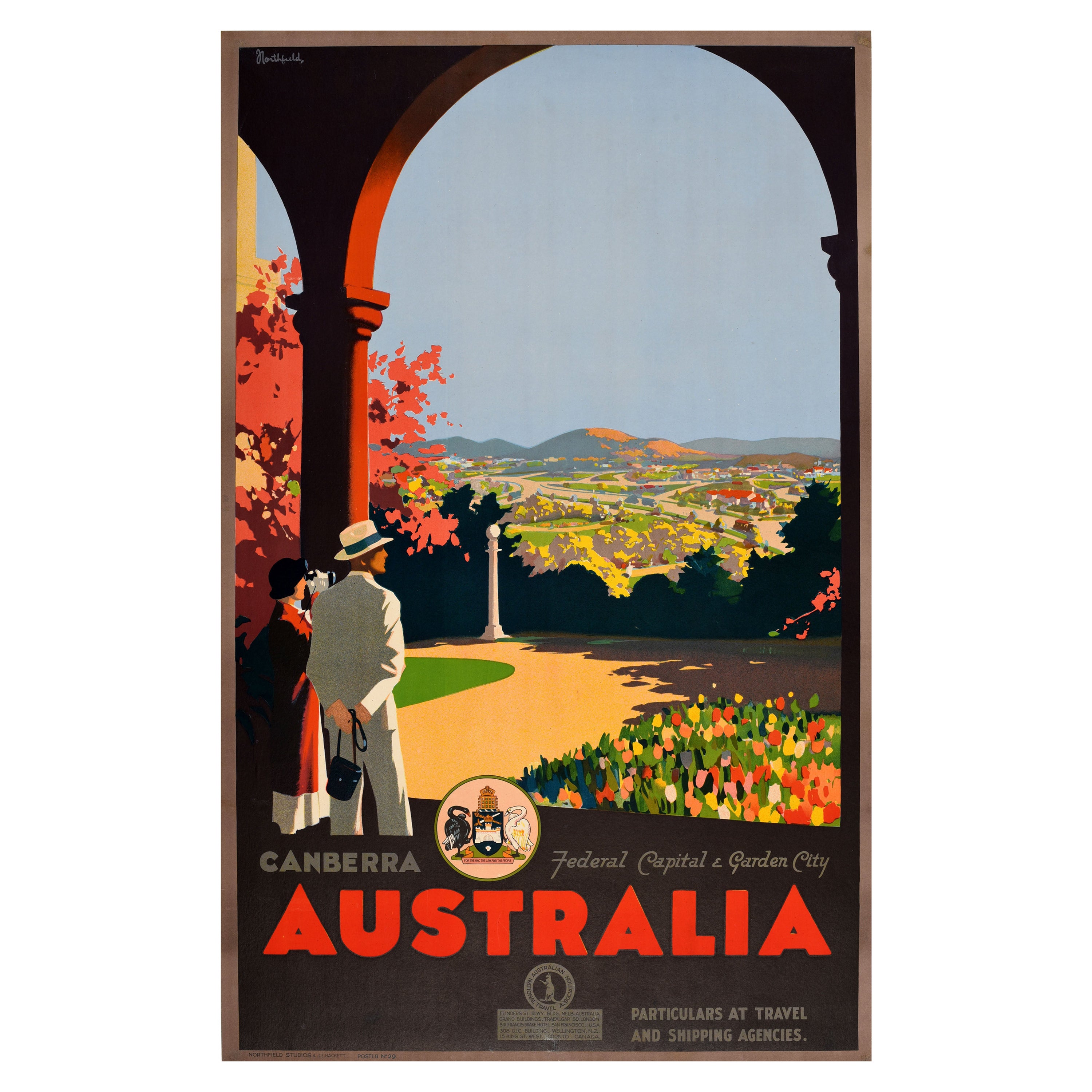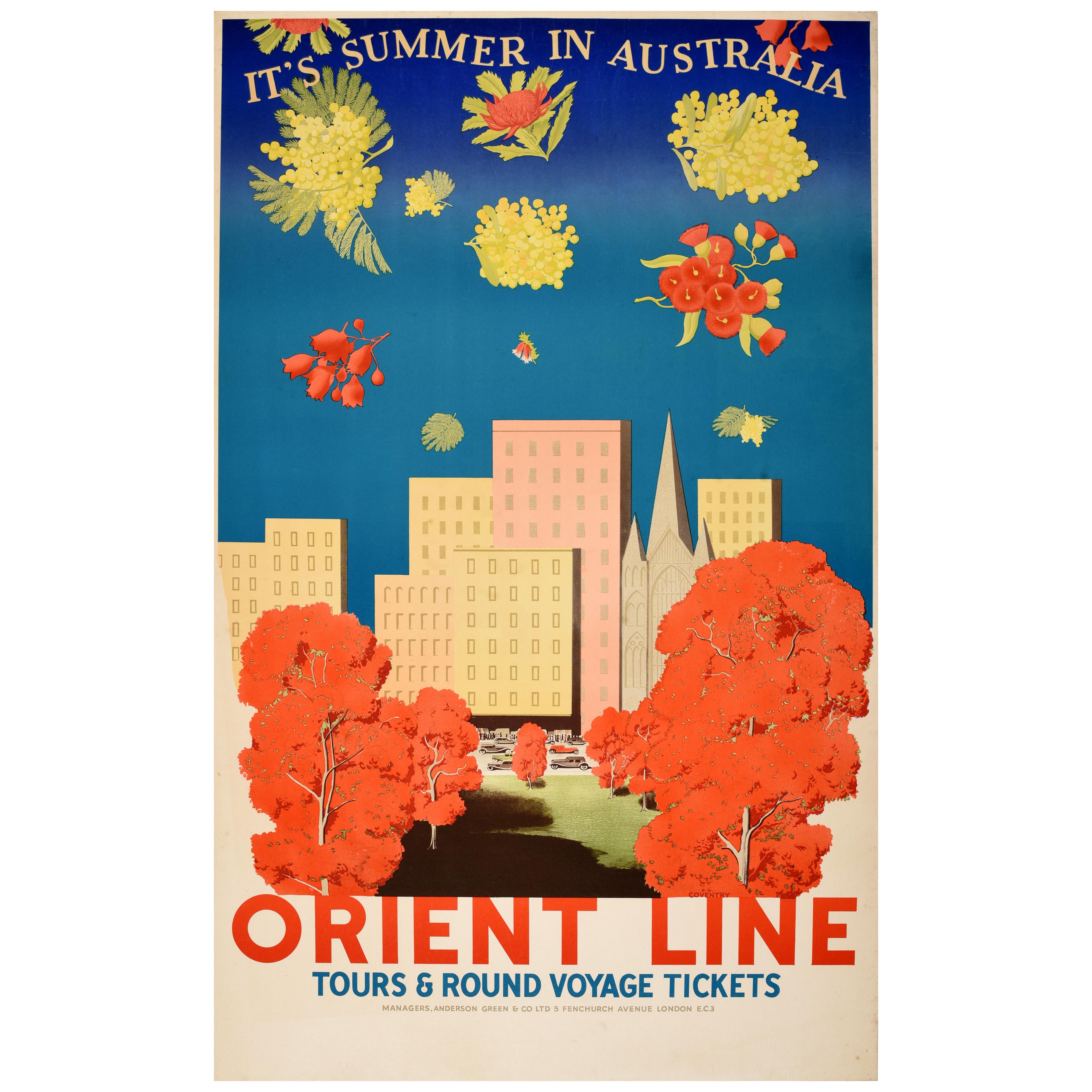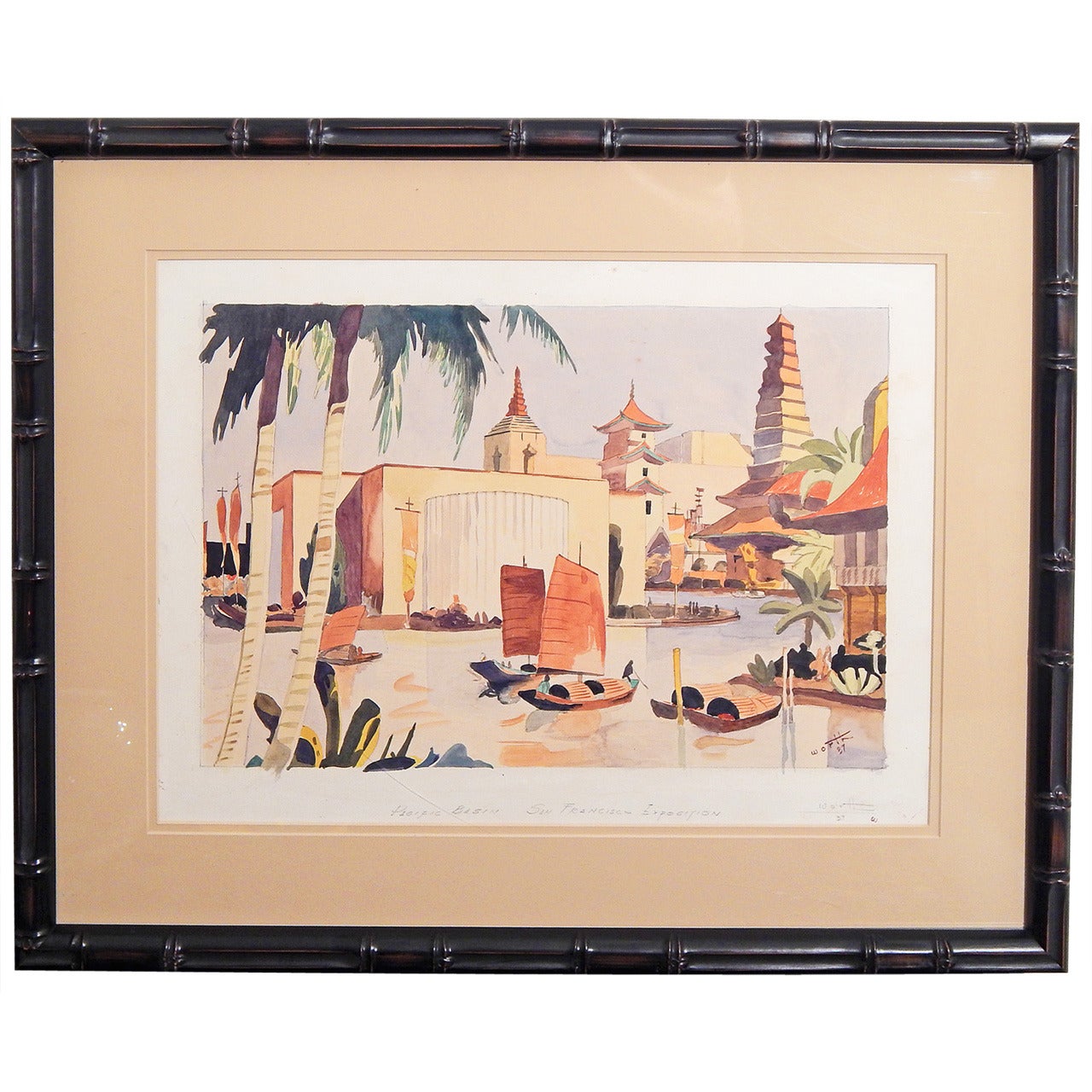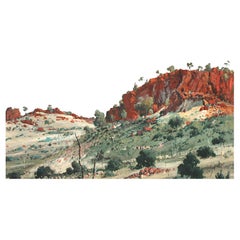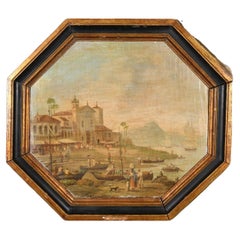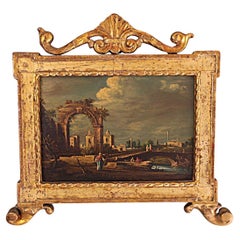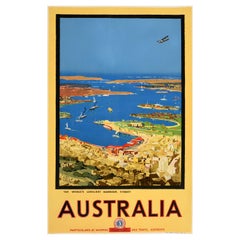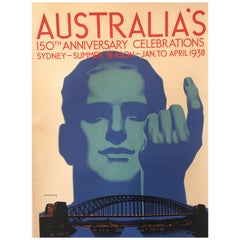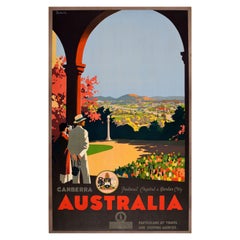Items Similar to Australian Sydney Harbour Bridge design Painting 1932
Want more images or videos?
Request additional images or videos from the seller
1 of 12
Australian Sydney Harbour Bridge design Painting 1932
$1,027.62
£750
€874.83
CA$1,407.59
A$1,565.55
CHF 817.48
MX$19,051.04
NOK 10,440.46
SEK 9,791.31
DKK 6,529.23
Shipping
Retrieving quote...The 1stDibs Promise:
Authenticity Guarantee,
Money-Back Guarantee,
24-Hour Cancellation
About the Item
Sydney Harbour poster
Sydney Harbour Bridge poster design
Attributed to Douglas Annand in our opinion, this was an original drawing for the 1932 poster competition.
In 1932, the poster competition committee asked Douglas Annand and Arthur Whitmore to collaborate together to produce the now-famous 19th March 1932 poster.
There are clear similarities between ours and the collaborative poster.
Our design clearly shows more of an Art Deco and feminine design, as opposed to the more masculine, collaborative Sydney Harbour Bridge poster design.
Our drawing is Gouache on paper laid down on the artist's board.
The drawing is in the original frame and mount, dated March 1932 and is unsigned.
BIOGRAPHY
Douglas Shenton Annand (1903-1976), graphic designer and artist, was born on 22 March 1903 at Toowoomba, Queensland, the third child of Frederick William Gadsby Annand, accountant, and his wife Helen Alice, née Robinson, both Queenslanders. Having taken the commercial course at the Central Technical College, Brisbane, in 1920, Douglas joined the English, Scottish & Australian Bank. Five years later, he began work as a commercial artist at Reed Press and attended night classes at Brisbane Central Technical College under L. J. Harvey. While being taught by F. J. Martyn Roberts, Annand freelanced in 1926: he was commissioned by a Brisbane jewellery firm and prepared wildflower designs for the Royal Worcester Co. Ltd, England. On 18 August 1928, he married Maida Fulcher Morris (d.1954) at the Ann Street Presbyterian Church, Brisbane; they were to have two sons.
He was employed by Samson Clark & Co. Ltd, an advertising agency, from 1928 and transferred to its Sydney office in 1930; retrenched, he joined Allied Advertising Artists. In 1931, he left to become a freelance artist and designer. Working from his studio in Sydney, he was initially assisted by his sister Helen. At first, he concentrated on graphic design, especially for textiles, wrapping papers, labels, magazine covers and advertisements. Between 1935 and 1939, he drew for Sydney Ure Smith's publications, the Home, Art in Australia and the Australian National Journal. In 1937 he designed the ceiling for the Australian pavilion at the Paris International Exhibition; he was art director (1938-39) of the Australian exhibition at the New York World's Fair, where his murals brought major recognition.
In 1941-44, Annand was a camouflage artist with the Royal Australian Air Force. Stationed for two years in North Queensland, he painted and drew regularly, and exhibited watercolours in Sydney and Melbourne. His linear style often used simple colour washes for dramatic effect. The strongest paintings placed ambiguous perspectives and compressed forms in a symbolic relationship and united them with the landscape to form a framing but a secondary aspect of the composition. Some of these works revealed the influence of the British artist Paul Nash. After the war, Annand became more involved in mural painting and completed commissions for the Peninsular & Oriental Steam Navigation Co., the office of radio station 2ue, the University of Melbourne's new Wilson Hall and the international terminal at Sydney airport. From the mid-1950s, he developed an interest in architectural work, like the large, glass structures he completed in 1966 for the Colonial Sugar Refining Co., Sydney.
Tall and balding, with brown eyes and a trim moustache, Annand was gentle in manner and a discursive talker. His innovative experiments with diverse media led to new approaches and injected vitality into the design arts. In 1932, he won a competition to design a poster to celebrate the opening of the Sydney Harbour Bridge. Awarded two Australian Commercial and Industrial Artists' Association medals in 1940, he won the Sulman Prize for his murals in 1941, 1947 and 1951. His posters won prizes in 1960 at the Adelaide Festival of Arts and in 1968 at Milan, Italy. He was a member of the Society of Artists, the Contemporary Art Society, Sydney, and the Society of Industrial Designers, London.
On 12 March 1957 at Wesley Church, Melbourne, Annand married a divorcee, Ann Selwyn, née Moran, late McCrae; he divorced her in 1962. Survived by a son of his first marriage, he died on 14 December 1976 at Wahroonga, Sydney, and was cremated. His work is held in the National Gallery of Australia and the Australian War Memorial, Canberra, and in State galleries in Brisbane, Melbourne and Sydney.
Source
Bettina MacAulay, 'Annand, Douglas Shenton (1903–1976)', Australian Dictionary of Biography
- Attributed to:Douglas Annand (Artist)
- Dimensions:Height: 16.15 in (41 cm)Width: 25.6 in (65 cm)Depth: 1.19 in (3 cm)
- Style:Art Deco (Of the Period)
- Materials and Techniques:
- Place of Origin:
- Period:
- Date of Manufacture:1932
- Condition:Minor fading.
- Seller Location:Seaford, GB
- Reference Number:1stDibs: LU10376244775012
About the Seller
New to 1stDibs
Joined in the past six months.
No Reviews Yet
Vetted Professional Seller
Every seller passes strict standards for authenticity and reliability
Established in 2021
1stDibs seller since 2025
Typical response time: 1 hour
- ShippingRetrieving quote...Shipping from: Seaford, United Kingdom
- Return Policy
Authenticity Guarantee
In the unlikely event there’s an issue with an item’s authenticity, contact us within 1 year for a full refund. DetailsMoney-Back Guarantee
If your item is not as described, is damaged in transit, or does not arrive, contact us within 7 days for a full refund. Details24-Hour Cancellation
You have a 24-hour grace period in which to reconsider your purchase, with no questions asked.Vetted Professional Sellers
Our world-class sellers must adhere to strict standards for service and quality, maintaining the integrity of our listings.Price-Match Guarantee
If you find that a seller listed the same item for a lower price elsewhere, we’ll match it.Trusted Global Delivery
Our best-in-class carrier network provides specialized shipping options worldwide, including custom delivery.More From This Seller
View AllTugboats on the River Thames with London Bridge – Mid-Century Oil Painting
By Pauline Boumphrey
Located in Seaford, GB
Lovely atmospheric oil painting of tug boats on the River Thames with London Bridge in the background.
This midcentury oil painting captures a dynamic and bustling scene of tugboats ...
Category
Vintage 1950s English Mid-Century Modern Paintings
Materials
Canvas
Vintage Frank Pash Australian Outback Painting
Located in Seaford, GB
Vintage Frank Pash Australian Outback Painting – Rare Collectable Artwork
Frank Pash, Australian Outback Painting, is a renowned Australian outback artist. He was born in Australia ...
Category
Mid-20th Century Australian Mid-Century Modern Paintings
Materials
Canvas, Wood
$3,031 Sale Price
25% Off
Early 19th century Capriccio Brazil School Painting
Located in Seaford, GB
Rare Early 19th century Capriccio view of Rio de Janeiro Painting
Probably painted circa 1810 by one of Jean-Baptiste Debret, Italian Students.
Painted on Sailcloth.
Historical Context of Early 19th Century Portuguese Colonial Brazil
1.1 Transition from Colony to Empire
During the early 19th century, Brazil underwent a seismic shift in its political status. Originally a colony under the Portuguese Empire, the arrival of the Portuguese Royal Court in Rio de Janeiro in 1808 rapidly elevated the city’s cultural and political importance. By 1815, Brazil was declared a kingdom united with Portugal, setting the stage for the emergence of the Empire of Brazil in 1822. This period of transformation—often termed the transitional period from colony to empire—fueled a wave of artistic production in cities like Rio de Janeiro.
1.2 European Artistic Influence in Brazil
With the French Artistic Mission in Rio (initiated in 1816) and the presence of various Portuguese and European artists, Brazilian art of the early 1800s began to reflect diverse influences, from neoclassical painting to the early rumblings of romanticism. Painters such as Jean-Baptiste Debret, and Nicolas-Antoine Taunay, and local luminaries like Manuel de Araújo Porto-Alegre contributed to the fine arts tradition in Brazil. Their works featured scenes of local life, portraits of Brazilian society, and imaginative vistas—sometimes referred to as “capriccios,” in which real elements were combined with artistic liberties to create an idealized panorama.
1.3 Rio de Janeiro as Cultural and Political Hub
Rio de Janeiro, often called the Imperial capital after Brazil’s independence, was home to foundational institutions like the Imperial Academy of Fine Arts (Academia Imperial de Belas Artes). Later evolving into the Escola de Belas Artes (School of Fine Arts in Rio), these academies nurtured the talents of emerging painters, who found patronage under the Royal Court and, subsequently, the Imperial Court. The city’s significance was further enhanced by the construction of significant buildings, the modernization of infrastructure, and the mingling of European courtly customs with the traditions of local inhabitants.
. Description of the Octagonal Oil on Canvas: A Capriccio View of Rio de Janeiro
2.1 Composition and Layout
The most striking characteristic of this 19th-century Brazilian art piece is its octagonal shape, a relatively unusual format that draws the viewer’s gaze toward its centre. The composition showcases Rio de Janeiro’s shoreline in the early 1800s, brimming with merchant ships and smaller boats anchored near the shore. On the sand, there is a bustling crowd of local people—men and women carrying food and goods on their heads, loading and unloading boats, and engaging in everyday commerce. The backdrop of soaring mountains suggests Rio’s iconic topography, embodying the landscape that famously defines the city.
2.2 Architectural and Religious Landmarks
On the left side, one can discern the silhouette of a church believed to be Santa Lucia, a significant religious structure in the heart of early 19th-century Rio. This element provides viewers with a tangible reference point, linking the scene to an actual location. However, because this painting is labelled as a “capriccio,” the artist might have taken creative liberties by rearranging or amplifying certain features of the city. The melding of real and idealized elements is characteristic of these imaginative vistas.
2.3 Evoking Daily Life in Colonial Rio
One of the painting’s greatest appeals lies in its portrayal of daily life during the colonial era. Men and women from various backgrounds populate the scene. Some appear to be carrying goods on their heads, a common practice in Brazil that has persisted through different centuries. Others appear to be haggling or trading near small vessels, revealing the commercial pulse of an active port city. This focus on local people, combined with the grandeur of merchant ships, captures the tension and synergy between the every day and the extraordinary—a hallmark of Brazilian colonial painting that balances the grand narratives of empire with the rhythms of ordinary life.
2.4 An Amalgamation of Neoclassical and Romantic Influences
Although academic art in early 19th century Brazil was highly influenced by neoclassicism, the onset of romanticism can be spotted in the emotional portrayal of the sky, the lively palette, and the dramatic emphasis on nature’s beauty (the mountains, in particular). This duality reflects the fine arts tradition in Brazil during the transitional phase when artists were embracing multiple styles. As part of the School of Rio or the Rio de Janeiro school, painters often integrated academic techniques learned from European masters with emerging local subjects and influences.
3. Institutions and Artistic Movements
3.1 Imperial Academy of Fine Arts
Originally known as the Royal School of Sciences, Arts, and Crafts, the Imperial Academy of Fine Arts in Rio de Janeiro was instrumental in shaping 19th-century Brazilian art. Influential artists and teachers from Portugal, France, and other European nations congregated at the Academy, imparting their expertise to native students. As the monarchy consolidated power, the Academy enjoyed royal patronage, leading to the creation of Imperial Academy-style works that combined European academic rigour with Brazilian-themed subject matter.
3.2 Impact of the French Artistic Mission
The French Artistic Mission, which arrived in 1816, played a pivotal role in introducing advanced European artistic techniques, thereby elevating the overall quality of painting in Brazil. Artists like Jean-Baptiste Debret not only documented Brazilian society but also spearheaded the development of a local visual identity that aligned with both academicism and the national context of a blossoming empire. Debret, alongside others such as Nicolas-Antoine Taunay, mentored Brazilian artists, sowing the seeds of what would become the Brazilian academic art movement.
3.3 Religious, Historical, and Landscape Paintings
In addition to everyday scenes and historical compositions, religious iconography remained crucial throughout Portuguese colonial and imperial Brazil. Churches were omnipresent in cityscapes like Rio de Janeiro. Many colonial-era Brazilian portraits...
Category
Antique Early 19th Century Brazilian Spanish Colonial Paintings
Materials
Canvas
$2,959 Sale Price
20% Off
Antique Venetian capriccio oil painting
Located in Seaford, GB
Francesco Guardi Venice Oil Painting – Venetian Art in the Manner of Guardi
Exquisite 19th-Century Venetian Oil Painting
Experience the timeless elegance of Venetian art with this r...
Category
Early 20th Century Paintings
Materials
Pine, Paint
$1,699 Sale Price
20% Off
French Riviera Mediterranean Harbour Scene
Located in Seaford, GB
Fabulous Midcentury South of France Mediterranean Harbour Scene – South Of France Mediterranean Oil Painting
This exquisite South of France Mediterranean Oil Painting beautifully captures the essence of a South of France coastal scene, transporting viewers to a serene sun-drenched port where life moves at a relaxed, rhythmic pace. This vintage seaside artwork is a masterful portrayal of the picturesque fishing villages of the French Riviera, featuring azure blue waters, colourful boats, and rustic whitewashed buildings with terracotta rooftops.
The artist’s expressive brushstrokes and keen eye for detail bring to life the tranquillity of the Mediterranean, making this piece a perfect addition to any coastal home, vintage art collection, or midcentury-inspired interior. Whether displayed in a Sussex beach house, a contemporary living space, or a collector’s gallery, this artwork captures the warm, nostalgic charm of a bygone era.
South Of France Mediterranean Oil Painting – A Timeless Coastal Masterpiece
The focal point of this painting is the harbour’s crystal-clear waters, where a fleet of traditional fishing boats floats gently, their vivid reds, blues, and yellows contrasting against the deep turquoise sea. The artist expertly conveys the movement of the water, reflecting the brilliance of the sun and the soft dance of the ripples. Fishing nets, mooring ropes, and maritime gear are scattered along the quayside, suggesting a day’s work is completed, adding an element of authenticity and character to the composition.
Beyond the boats, a charming row of Mediterranean buildings lines the harbour, their sun-bleached facades glowing in warm ochres, soft creams, and earthy oranges. These structures, reminiscent of Provençal architecture, exude rustic elegance, with wrought-iron balconies, wooden shutters, and cascading bougainvillaea adding charm. The artist has captured the laid-back atmosphere of a French coastal town, making this painting an inviting French Riviera wall art piece that radiates warmth and nostalgia.
Seaside Village Life – A Celebration of Mediterranean Culture
On the quayside, villagers and fishermen are depicted through loose yet expressive brushstrokes, illustrating the bustling yet peaceful rhythm of daily Mediterranean life. Whether mending nets, chatting along the harbour, or preparing to set sail, the figures add a dynamic yet harmonious element to the scene, embodying the spirit of French coastal living.
The inclusion of palm trees, sun-drenched stone streets, and lush greenery enhances the atmosphere, reinforcing the idyllic charm of this vintage seascape painting...
Category
Mid-20th Century French Mid-Century Modern Decorative Art
Materials
Acrylic
18th century Fine Italian Grand Tour gouache of Palladian Villa
Located in Seaford, GB
This fine 18th-century gouache on paper is a quintessential example of Grand Tour artistry, depicting an Italian Palladian villa rendered with architectural precision and classical r...
Category
Antique Mid-18th Century Italian Grand Tour Paintings
Materials
Paper
You May Also Like
Original Vintage Poster Sydney Bridge Celebrations D Annand and D Whitmore, 1932
By D. Annand & A. Whitmore
Located in Melbourne, Victoria
This evokative Art Deco poster promotes the celebrations associated with the opening of what was to become a national and international icon, the Sydney Bridge, 1932. A statuesque lifesaver dominates the scene while spectators clad in swimwear watch the harbour pageantry from shore.
Original vintage poster Sydney...
Category
Antique Early 19th Century Australian Art Deco Posters
Materials
Paper
$30,000
Free Shipping
Original Vintage Travel Poster Australia Sydney Loveliest Harbour Art Deco
Located in London, GB
Original vintage travel poster for Australia The World's Loveliest Harbour Sydney featuring a stunning painting by Albert Collins (1883-1951) depicting an aerial view over the docks,...
Category
Vintage 1930s Australian Art Deco Posters
Materials
Paper
Original Vintage Poster 'Australia's 150th Anniversary Celebrations', 'c. 1938'
By Tom Purvis
Located in Melbourne, Victoria
Original vintage poster 'Australia's 150th Anniversary Celebrations', (c. 1938)
This is an original poster from 1938 by Tom Purvis, this poster is also part of the collection of t...
Category
Vintage 1930s Australian Art Deco Posters
Materials
Paper
$5,200 Sale Price
20% Off
Original Vintage Travel Poster Australia Canberra Federal Capital & Garden City
By James Northfield
Located in London, GB
Original vintage travel poster for Canberra Federal Capital & Garden City Australia featuring a stunning scenic view by James Northfield (1888-1973) with a couple in the foreground, ...
Category
Vintage 1930s Australian Art Deco Posters
Materials
Paper
Original Vintage Cruise Travel Poster Orient Line Australia Art Deco Summer
Located in London, GB
Original vintage Art Deco cruise travel poster advertising Orient Line Tours and Round Voyage Tickets - It's Summer In Australia - featuring a great design by Frederick Halford Coven...
Category
Vintage 1930s British Art Deco Posters
Materials
Paper
"Pacific Basin, " Art Deco Painting of Golden Gate Expo in San Francisco
By May French Worth
Located in Philadelphia, PA
Beautifully painted in tones of burnt sienna, cream and watery blue, this rare and early view of the Golden Gate Exposition was painted in 1937, just as Treasure Island was being cre...
Category
Vintage 1930s American Art Deco Paintings
Materials
Paper, Paint
$2,080 Sale Price
20% Off
More Ways To Browse
Art Deco Australia
Jewelry From 1962
Original By Robert Jewelry
Wilson Jewellery
Originals By Robert Vintage Jewelry
Samson Paris
Vintage Alice Jewelry
Douglas Wilson
British Colonial Posters
Butterscotch Bakelite
Ceramic Persian Tile
Cerused Oak Chest
Champleve Urn
Chinese Bronze Elephant
Chinese Carved Stone Animals
Chinese Dragon Cabinet
Chinese Embroidery Bird
Chinese Low Kang Tables
